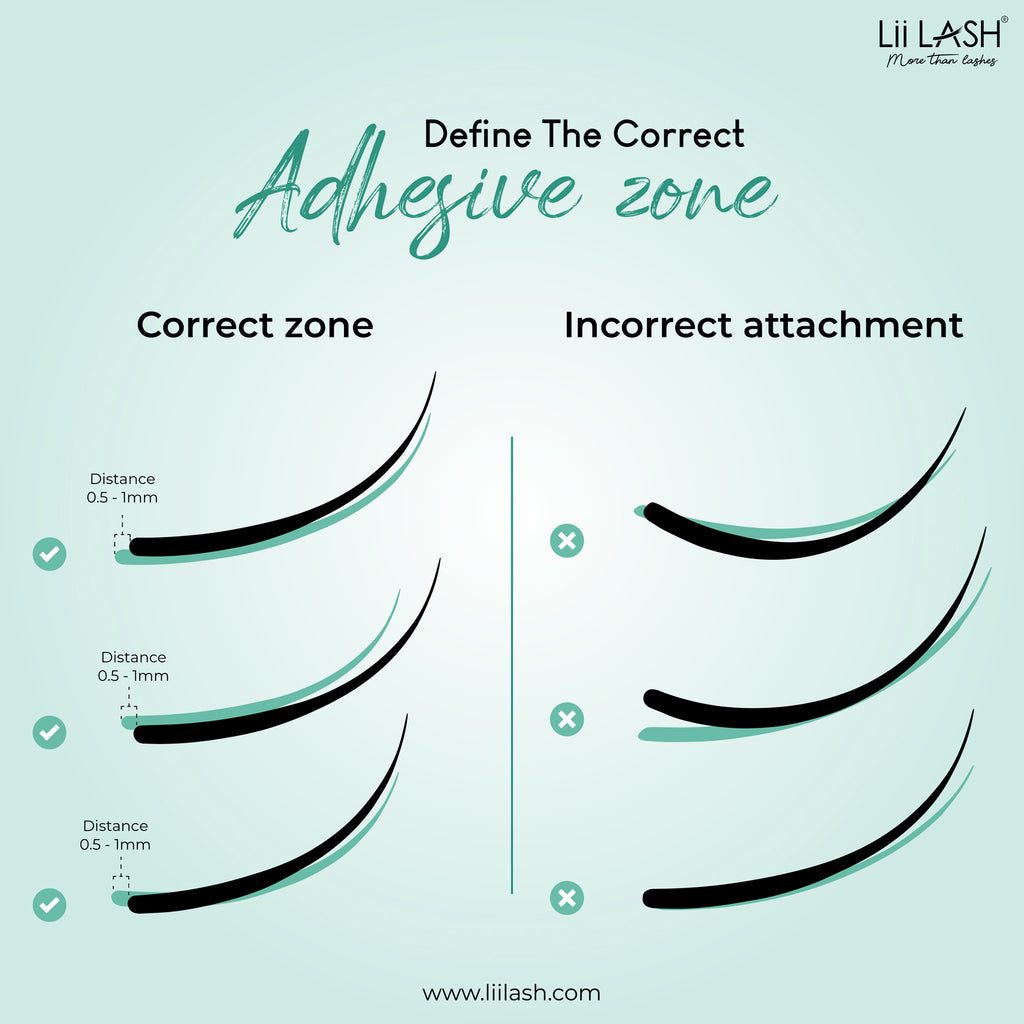Lash Layering Technique: For Beautiful Volume Lash Set
You want to create more voluminous lash set without creating mega volume and more ? Clients craving more depth and drama in their lash look? Then lash layering is your new best friend! This hot technique is taking the lash extension world by storm, and for good reason.
Think of lash layering as building a masterpiece. Unlike traditional method, layering allows you to add texture and dimension, creating truly unique sets. It's the secret weapon for achieving wispy elegance or bold, voluminous drama.
What's wrong with traditional application technique?
In traditional lash application, lash artists typically work their way horizontally across the entire lash line, treating it as a single layer. This involves finding, isolating, and attaching extensions one by one, typically starting from one corner and working towards the other. After completing this initial pass, they'll often do one or two additional checks to identify any gaps and fill them in with additional extensions.

While this approach is a common starting point, it has some limitations.
- Missed Lashes: It's easy to miss hidden or smaller natural lashes, especially towards the inner and outer corners. This can result in an uneven lash line.
- Tiring Eyes: constantly scanning back and forth across the lash line – now filled with both extensions and natural lashes – can be visually tiring for the lash artist's eyes.
- Inefficient Use of Time: Moving from one corner to the other and then back for checking gaps can be time-consuming, especially for lash artists who are still developing their speed.
- Clumping: If not careful, applying all extensions sequentially can lead to accidentally attaching multiple extensions to one natural lash, causing clumping and discomfort.
Understanding Lash Layering
Why Was Lash Layering Born a Star?
Believe it or not, our natural lashes aren't just a single row of soldiers standing in perfect formation. They actually have different layers! These layers create natural depth and texture, which is exactly what lash layering aims to mimic and enhance.

Traditional application method, while beautiful, can sometimes look a bit flat. That's why Lash layering was born. It emerged as a way to break free from this limitation, allowing lash artists to create more dimensional and dramatic sets.
So, what is Lash Layering?
Lash layering is a technique where lash extensions are applied on multiple layers of your natural lashes (top, middle, bottom) to create textured, dramatic lash sets with more depth and volume. Unlike traditional application where you work across the entire lash line, layering involves isolating and applying extensions on each layer one at a time
Benefits of Lash Layering
- Enhanced Creativity: Layering opens doors to a world of customization, allowing you to create unique, textured sets that cater to each client's individual desires.
- Simplified Isolation: This technique offers a more manageable approach to isolation compared to traditional methods, especially for beginners or when dealing with multiple lash layers.
- Improved Efficiency: The taping technique in layering streamlines the isolation process, saving you valuable time during application. Instead of looking at all lash lines you can have a better view of divided layers
- Boosted Client Satisfaction: Offering a wider variety of lash styles with added volume and texture can lead to happier clients who rave about your skills.
- Increased Volume and Texture: Layering adds depth and dimension to the lashes, creating the illusion of fuller, more voluminous lashes.
- Easier to Find Lashes: It's like having a smaller, more manageable section of cake (lashes) to work on, making it easier to find healthy lashes for extensions.
- Less Clumping: With fewer lashes exposed at once, there's less risk of accidentally attaching extensions to multiple lashes, which can cause clumping.
- Faster Application: You don't have to search the entire lash line for good lashes. This "layering" technique saves you valuable time during application.
Lash layering offers a stunning way to create textured, dramatic lash sets. However, like any technique, it has its advantages and disadvantages for both lash artists and clients.
- Increased Application Time: Layering takes more time compared to traditional lash application due to the additional steps involved in isolating and working with multiple lash layers.
- Higher Skill Level Required: Mastering isolation and proper placement within multiple layers demands a higher level of skill and precision from the lash artist.
- Not Suitable for All Clients: Clients with weak or sparse natural lashes might not be suitable candidates for layering due to the additional weight on the lashes.
- Discomfort (for some clients): Layering can involve more manipulation of the eyelid and natural lashes, which some clients might find uncomfortable.
How to Do Lash Layering? A Step-to-Step Guide
1. Preparation
Tools and Materials:
Lash layering differs from regular lash application in how extensions are attached. You'll still need the same tools and materials for both techniques.
- Tweezers: You'll need two pairs – pointed tweezers (like H2 tweezers) for precise isolation during layering and curved tweezers for classic application.
- Lash Trays: Stock up on a variety of lash lengths, curls, and thicknesses to create different effects in each layer.
- Micropore Tape: This gentle tape will help expose lash layers for easier isolation.
- Lash Adhesive: Choose a high-quality adhesive with a suitable drying time (for your expertise)
Lash Selection for Layering:
The key to gorgeous layered lashes lies in the right lash selection. Here's what you need to know:
Lengths: Utilize a mix of shorter and longer lashes. Shorter lengths will create a wispy effect, while longer ones add drama and volume.
Curls: Choose curls that complement your client's natural lashes. For clients with straighter lashes, opt for a slight curl like B or C, whereas those with naturally curled lashes can benefit from a flatter curl.
2. Taping for Layered Isolation:
- Tape Selection: Use sensitive, lash-safe tape to avoid damaging natural lashes.
- Taping Technique: Gently tape back all natural lashes in two sections, up and down. This creates a manageable area to work on and keeps other lash layers out of the way.
3. Exposing and Isolating Lashes:
Once all the lashes are taped, carefully reveal a layer of natural lashes with a tweezer.
Use pointed tweezers for precise isolation within the exposed layer. Their precision is crucial for isolating individual lashes within the exposed layer. The lifted lashes resemble naturally curly lashes, making curved tweezers less effective for isolation in this context.

By working on exposed sections, isolating individual lashes becomes a breeze. No more fumbling or missing lashes hidden in the crowd!
4. Extension Application:
Placement
Extensions are applied on top or below the isolated natural lashes. This placement might differ based on the client's natural lash curl. For clients with straighter lashes, extensions might be applied on top instead. For clients with uplift curl, extensions might be applied on the bottom.
Also, for different layers, extensions might be applied different position. Most commonly, there are three main layers: top, middle, and bottom:
- Bottom Layer: Extensions are applied on top of the natural lash. This creates a dark lash line and adds volume at the base.
- Middle Layer: Extensions are placed in between natural lashes for added texture and fullness.
- Top Layer: Extensions are applied underneath the natural lash for a lifted, wispy appearance.

Bonding
It's crucial to achieve a secure bond at the base of the natural lash, ideally around 0.05mm. A slight gap between the extension and the natural lash base is acceptable. This space allows for natural shedding of the real lash without hindering growth or damaging the delicate skin around the eye area.

If you're beginner, a slightly larger gap might be okay initially, but avoid attaching extensions directly to the skin at all costs. This can harm both the natural lashes and the delicate skin around the eyes.
Glue Management
Maintain clean tweezers by wiping excess glue with a lint-free wipe or using a dedicated cleaning solution.
5. Checking and filling:
- Gap Identification: After completing a layer, check for any missed lashes or gaps.
- Sticky Identification: Gently separate any lashes that might be stuck together to ensure healthy lash growth.
- Filling Technique: Use shorter lash extensions to fill gaps and create a wispy effect.
6. Repeating the Process:
- Tape Removal: Carefully remove the tape to expose the next layer of natural lashes.
- Repeating Steps: Repeat steps 2-4 for each exposed layer until you achieve the desired lash fullness.
Want to see lash layering in action? Check out this helpful video, "Lashing in Layers" by Yegi Beauty
Advanced Layering Techniques:
Creating Specific Effects: Use strategic lash placement and layering to achieve different effects like cat-eye, doll eye, or open eye.
Adding Texture and Drama: Incorporate wispy lashes, spikes, and closed fans for a more dramatic and textured look.
Maintain Lash Direction: Throughout the layering process, ensure all extensions follow the natural direction of your client's lashes.
Conclusion
Lash layering is a powerful technique for creating visually stunning lash sets. By mastering this technique, you can craft stunning textured lash looks that cater to each client's desires. From subtle enhancements to dramatic volume, lash layering offers endless options for unleashing your artistry.







